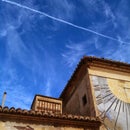Introduction: LED Clock
Please find my Arduino clock project using the UNO board and Adafruit's Neopixels. It is a work in progress, so please be patient with my tutorial.....It will become more detailed as I get some time up my sleeve. The code and wiring details are to be found on GitHub (see links ahead).
Step 1: Parts Required.
x1 10K resistor
x1 430R resistor
x1 LDR (light dependent resistor)
x1 12 LED Neopixel ring (Adafruit)
x1 60 LED Neopixel ring (Adafruit) - note that the ring comes in four parts
x1 RTC DS1307 (real time clock)
x1 Arduino UNO R3 board
x1 breadboard
wires
Step 2: The Hardware Layout (As Per Fritzing Design).
https://github.com/SteveDeDomenico/Arduino-Uno-LED...
You can download the Fritzing diagram to help assist in the wiring of the project. Note that the resistor is a 10K one.
Attachments
Step 3: The Code.
https://github.com/SteveDeDomenico/Arduino-Uno-LED...
The code can be found at GitHub for download. As I get some time, I will discuss some of the code in more detail.
Attachments
Step 4: Videos of It Working.
Not the best of videos, but I thought it would be nice to show it working. I will upload better ones demonstrating some of the features.
Attachments
Step 5: The RTC.
The RTC DS1307 was used to help keep the correct time. Refer to the Fritzing diagram for correct wiring.
Step 6: The Separate Rings.
The small ring (12 LEDs) is used for the hour hand and the larger ring (60 LEDs) is used for the minutes and seconds hands. An LDR (Light dependent resistor) has been incorporated into the build to adjust the brightness of both rings. These rings can be purchased from the Adafruit website. Note that the 60 LED ring comes in four parts and needs to be soldered together.
Step 7: The UNO Board.
I used the UNO board, but others work just as well.
Step 8: An Artistic Finish to the Project.
A laser cut case was used to complete the project.
Step 9: Night Effect.
Note that the light sensitive resistor makes the LEDs less bright in the dark.













